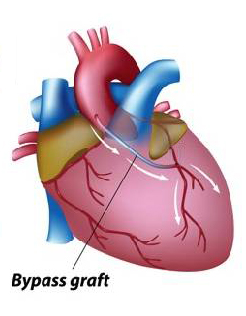Coronary artery disease is caused by hardening and subsequent blockage of the arteries that supply blood to the heart. The obstruction of the coronary arteries reduces the amount of blood reaching the heart muscle, resulting in
chest pain called angina pectoris. In severe cases, this may cause a life-threatening
heart attack, scarring of the heart or
heart failure.
The mainstay of treatment for coronary artery disease is medication, while some patients will require invasive intervention such as CABG.
How is coronary artery bypass grafting performed?

A bypass graft vessel allows oxygenated blood to bypass the blocked arteries and restore blood flow to the heart
In a CABG operation, the patient will be given a general anaesthetic before the chest is opened through the breastbone. A new graft vessel, which is a healthy artery or vein is taken from the patient’s leg, arm or chest, is surgically removed and sewn around the areas of the blockage by the surgeon.
The graft vessel supplies oxygenated blood to the part of the heart that needs it, thereby “bypassing” the blocked arteries and restoring blood flow to the heart muscle. The augmented blood flow improves symptoms, reduces the need for medications, and prolongs life in well-selected patients. More blood flow reduces angina and should also reduce the need for medication. The number of grafts needed will depend on the severity of the patient’s condition.
One or more plastic chest drains may be left in the chest temporarily to drain any fluid that may have collected during the surgery. If necessary, pacing wires may be temporarily left in the heart for heart rhythm control. The breastbone is then wired together and the skin wounds closed with self-dissolving sutures.
On-pump surgery
The traditional coronary artery bypass grafting (CABG) procedure involves connecting the patient to a heart-lung bypass machine which performs the function of the heart and lungs. The patient’s heart is then stopped with medication and the grafting process begins. Once the procedure is completed, the patient’s heart is restarted and the heart-lung machine is disconnected.
Who will need a coronary artery bypass surgery?
Coronary artery bypass grafting (CABG) is an established operation that is usually recommended to patients with coronary artery blockages to relieve the symptoms of
coronary artery disease:
These symptoms include:
- Chest discomfort (called angina pectoris), often described as ‘tight’, sometimes involving the jaw, left shoulder or arm.
- Pain in the neck, jaw, throat, upper abdomen or back.
- Breathlessness on exertion or when lying down.
- Heart attack during which you may even be breathless, sweaty with cold and clammy peripheries.
However, it is important to note that some patients (especially diabetics) may have absolutely no pain. If a heart attack occurs, CABG can also be performed as an emergency procedure to restore blood flow to the heart. If blood flow is not restored to the affected area, the heart muscles die and become scarred causing the heart to fail as an efficient pump.
Possible complications of CABG
Coronary artery bypass grafting (CABG) is considered a major surgery and in some cases might result in certain complications, including:
- Infection: The incision sites can become infected. This can be treated effectively with antibiotics and special dressings.
- Bleeding: This is a complication that is often seen in major surgeries.
- Irregular heartbeat: Arrhythmia can occur after a CABG though it is usually quickly treated with medication.
- Kidney problems: Some patients might develop kidney problems after a CABG but this is often temporary.
- Heart attack: Some patients might suffer a heart attack during or after the surgery.
Other CABG techniques
There are several other ways the CABG can be performed.
1) Off-pump surgery
The heart is stabilised at various parts, allowing the surgeon to proceed with the surgery while the heart is still beating. This technique reduces the risks of certain complications during or after the surgery. However, this technique is more challenging than the conventional on-pump procedure and is performed in selected patients.
2) Minimally invasive CABG methods
Minimally invasive CABG (also known as a keyhole surgery) is where small incisions are made, allowing surgical instruments to be inserted into the body. This technique could also involve the use of robotics and a video feed. Such procedures often lead to quicker recovery due to the significantly smaller wound sizes.
